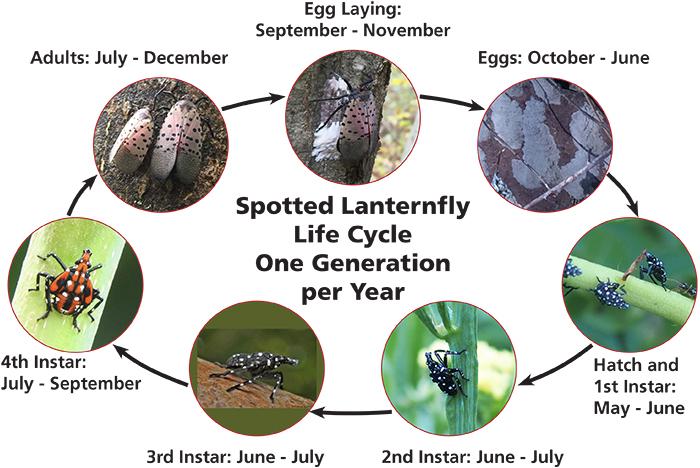This article contains outdated information. Please visit Extension's Home & Garden Information Center's page "Spotted Lanternfly for Residents" for current conditions in Maryland.
The spotted lanternfly (SLF) is a colorful and, I dare to say, pretty moth. This non-native, invasive pest native to Asia was first detected in the United States in 2014 in Berks County, Pennsylvania. In addition to Pennsylvania, it has been confirmed in Maryland, Delaware, New Jersey, West Virginia, and Virginia. In Maryland, Cecil and Harford Counties are under a quarantine. The first instar hatch was recorded in Cecil County in May 2020.

This type of insect, called a “planthopper,” prefers Tree of Heaven (Ailanthus altissima) yet can ravage grapes, hops, apples, blueberries, oak, pine and many more species. SLF can feed on over 70 different types of plants and crops.
Spotted lanternfly destruction results in oozing, wilting, defoliation, dieback, yield loss or quality reduction, reduction of cold hardiness and ultimately plant death. This invasive pest not only destroys the plants, it also excretes a sugary sticky “honeydew,” which looks like sap. Honeydew is the waste product of the spotted lanternfly. These droppings rain down on all types of structures including, vehicles/equipment, decking, pets, clothing and hair and attracts ants, wasp and other insects. A sooty mold develops from this honeydew that has detrimental effects that include crops becoming unmarketable, inhibiting photosynthesis, and producing an odor of fermentation leaving residents feeling like prisoners.
The spotted lanternfly has no natural predators. However, there are actions that can be taken to mitigate the negative effects and help keep SLF from expanding its range. These actions include:

- Learn how to ID life stages
- Find out where the quarantine zones are:
- https://www.dontmovefirewood.org/pest_pathogen/spotted-lanternfly-html/
- When visiting a quarantine zone:
- Keep vehicle windows closed
- Do not park underneath where SLF might congregate
- Keep door closed except when loading is taking place
- Inspect your vehicle (inside and out) before departure
- Biocontrol: predators, parasitoids, and fungi
- Good old fashioned squishing, destruction of egg masses, and instars and adults.
- Circle Traps or sticky bands
- Chemical spray treatments such as spray or contact insecticide applications
- Trunk spray or tree injection systematic injections
If You See It, Report It! If you observe any egg masses or insects which look similar to this, please try to collect them, and inform the Maryland Department of Agriculture at (410) 841-5920 or DontBug.MD@maryland.gov as soon as possible.
Working together and keep an eye open and taking action against these beautiful yet destructive pests will enable scientists, the Maryland Department of Agriculture, and the Department of Natural Resources to act quickly to help protect Maryland forests and valuable crops.
